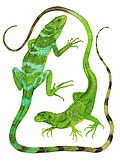Ctenosaura palearis
| Ctenosaura palearis | |
|---|---|

| |
| Guatemalan spiny-tailed iguana | |
| Scientific classification | |
| Domain: | Eukaryota |
| Kingdom: | Animalia |
| Phylum: | Chordata |
| Class: | Reptilia |
| Order: | Squamata |
| Suborder: | Iguania |
| Family: | Iguanidae |
| Genus: | Ctenosaura |
| Species: | C. palearis
|
| Binomial name | |
| Ctenosaura palearis Stejneger, 1899
| |

| |
Ctenosaura palearis, commonly known as the Guatemalan spiny-tailed iguana, is a species of spiny-tailed iguana endemic to the Motagua Valley, Guatemala.
Conservation status
This species is threatened by habitat loss and illegal trade. These iguanas were used as a source of food by natives. Its eggs are a food source for the equally threatened Motagua Valley beaded lizard (Heloderma horridum charlesbogerti), thereby possibly linking the status of the two species. It is included in CITES appendix II so that trade of this species is regulated.[1]
Diet
The Guatemalan spiny-tailed iguana feeds on leaves and the fruits of the cactus Stenocereus pruinosus and occasionally insects (crickets, beetles, ants and wasps).
Habitat
The habitat of C. palearis is characterized by a greater frequency of the cactus Stenocereus pruinosus, Albizzia idiopoda, Ximena americana and Acacia deamii. The Guatemalan spiny-tailed iguana can be regarded as a keystone species because it plays an important role in seed dispersal of S. pruinosus.[citation needed]
References
- ^ a b Ariano-Sánchez, D.; Pasachnik, S. (2011). "Ctenosaura palearis". IUCN Red List of Threatened Species. 2011: e.T44192A10860487. doi:10.2305/IUCN.UK.2011-1.RLTS.T44192A10860487.en. Retrieved 24 December 2017.
{{cite journal}}: Unknown parameter|last-author-amp=ignored (|name-list-style=suggested) (help)
- Coti, P. and D. Ariano. 2008. Ecology and traditional use of the Guatemalan black iguana (Ctenosaura palearis) in the dry forests of the Motagua Valley, Guatemala. Iguana 15 (3): 142–149.[1]
Further reading
- Stejneger, L. 1899. Description of a new species of spiny-tailed iguana from Guatemala. Proc. U.S. Natl. Mus. 21: 381–383.


